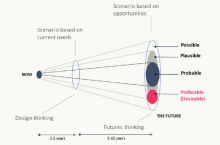
The furniture industry faces a mounting waste crisis, exacerbated by fleeting design trends and a linear "take-make-waste" model of production and consumption. To address this challenge and transition towards a more sustainable, circular economy, the industry must embrace futures thinking - the practice of envisioning and planning for potential future scenarios.
The Need for Circularity in Furniture
The furniture industry is a significant contributor to global waste, with an estimated 9 million tons of furniture waste generated annually in the EU alone. Much of this waste ends up in landfills or is incinerated, representing a lost opportunity to recover and reuse valuable materials.The linear model that has long dominated the industry - where products are manufactured, sold, used, and then discarded - is no longer tenable. A circular economy model, where materials are kept in use for as long as possible through strategies like reuse, repair, remanufacturing, and recycling, offers a more sustainable path forward.
The value of Futures Thinking
Transitioning to a circular economy in the furniture industry requires a fundamental shift in mindset, business models, and industry practices. Futures thinking can play a crucial role in enabling this transition.
By exploring a range of potential future scenarios, industry stakeholders can better understand the drivers, challenges, and opportunities that may shape the path towards circularity. This can inform strategic planning and help the industry prepare for a variety of possible futures. Futures thinking can also help identify the key leverage points - the areas where small changes can have a significant impact - in the furniture value chain. This can guide targeted interventions and investments to accelerate the transition to a circular economy. Transitioning to a circular economy requires coordination and collaboration across the entire furniture ecosystem, including manufacturers, retailers, consumers, and waste management providers. Futures thinking can facilitate this collaboration by creating a shared understanding of the desired future state and the steps needed to get there. As Policymakers play a crucial role in creating the enabling environment for a circular economy, futures thinking can also help inform the development of policies and regulations that incentivize circular practices, remove barriers, and drive the necessary systemic changes.
Practical Applications of Futures Thinking
Furniture companies and industry associations can leverage futures thinking in several ways:
Scenario Planning: Develop and explore multiple plausible future scenarios for the furniture industry, considering factors such as technological advancements, consumer preferences, regulatory changes, and resource availability.
Backcasting: Start with a desired future state, such as a fully circular furniture industry, and work backwards to identify the steps and milestones needed to achieve that vision.
Horizon Scanning: Continuously monitor emerging trends, technologies, and signals of change that could impact the industry's transition to circularity.
Stakeholder Engagement: Engage a diverse range of stakeholders, including industry players, policymakers, researchers, and consumers, to gather insights and build a shared understanding of the future.
By embracing futures thinking, the circular economy transition manager can navigate the complex and uncertain path towards a more sustainable, circular future, ensuring that the products designed and manufactured today are fit for the world of tomorrow.



